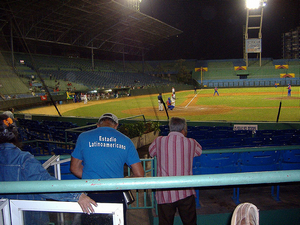 Anyone who claims to be from Havana has visited, at least once in their life, the old baseball stadium in the majority-black marginal neighborhood of Carraguao, in Cerro.
Anyone who claims to be from Havana has visited, at least once in their life, the old baseball stadium in the majority-black marginal neighborhood of Carraguao, in Cerro.
On October 26 it will be 64 years since the Cerro Stadium opened. One Sunday in 1946 it opened with a game between the Almendares and Cienfuegos clubs. At that time the stadium had a capacity of 30,000 fans.
Built at a cost of 2 million pesos, and headed up by the shareholder Bobby Maduro, the brand new headquarters for winter ball in Cuba started with four teams: Almendares, Havana, Marianao and Cienfuegos. Through the gates of the old place have passed the great stars of the national past-time.
From the immortal Martin Dihigo, the first Cuban to enter the Hall of Fame in Cooperstown, New York, to Orestes Minoso, Roberto Ortiz — who hit the first home run in the new stadium — Camilo Pascual, Luis Tiant, Pedro Fomental Agapito Mayor, Hector Rodriguez and the spectacular shortstop Willy Miranda, among many others.
Many players from the United States and the Caribbean, which were then stars in the Major Leagues, also played in the sacred precinct of Cuban baseball. The formidable American black pitcher Leroy “Satchel” Paige, and the man who was later a famous manager in the majors, Tommy Lasorda, drew applause in the stadium of the capital before 1959. Gringo sluggers Barry Bonds and Frank Thomas also stepped on this lawn when they were amateur players.
But not only baseball has been played in the big stadium. In the 1940s club matches were held for Spanish soccer league, such as Atletico Madrid and Celta Vigo, in the early 1960’s, the Brazilian Botafogo. Joe Louis, the “Detroit Bomber” and professional heavyweight champion of the world, fought there against the Cuban Omelio Agramonte.
The Mexicans Armillita Perez and Silverio staged a bullfight there. And an unprecedented event was when Sonja Heine, a famous Norwegian figure skater, performed her show on the ground turned into ice.
In 1957 the stadium hosted the Festival of 50 Years of Cuban Music, with the participation of Cuban artists living in other countries — Antonio Machin was one of them — and foreign guests such as the Puerto Rican Tito Puente and the Chilean Lucho Gatica.
In 1960, Fidel Castro changed its name to the Latin American Stadium. Then, in 1971, following the celebration in Havana of a world championship of amateur baseball, it expanded its capacity to 55 thousand spectators.
The terrain is natural grass, and it is 325 feet (99 meters) down the sides, 380 (106 meters) at the corners and 400 feet (121 meters) across at the center. It is the home of the Industriales, current national champions.
The best players from the island over the past 50 years have played on the grass at Cerro. Players who have hit home runs there include Luis Giraldo Casanova from Pinar del Rio and his compatriot Omar Linares, the most prominent baseball player since the revolution. Also making it theirs were the Santiagan Orestes Kindelan, who hit the longest national home run; Antonio Pacheco and on the mound Braudilio Vinent. Two superb players like as Pedro Antonio Muñoz and José Rodríguez, from the province formerly Las Villas, staged colossal duels with first class pitchers from the Industriales, the ninth Creole baseball logo.
More than 300 Cuban players who have defected played in the “Latino.” Some shone brightly: Kendry Morales, Orlando “El Duque” Hernandez and Jose Contreras. Others shook their legs to leave the ring. The All-Star lefty Aroldis Pichert Chapman, who now earns millions with the Cincinnati Reds, batted freely on the capital grounds.
In its 64 birthday, the old stadium in Cerro is worse than ever. The terrain is pretty bad. Its ability to drain after a heavy rain has deteriorated. And the roof is in a deplorable state.
The artificial lighting is terrible. Several towers are rusted and useless, presenting a danger of collapse. In the last year, the Industriales team has not been able to play at night. This prevents many fans, who have to work in the day, from coming to see the best club of the last half-century Cuba.
Photo: judithsweet, Flickr
